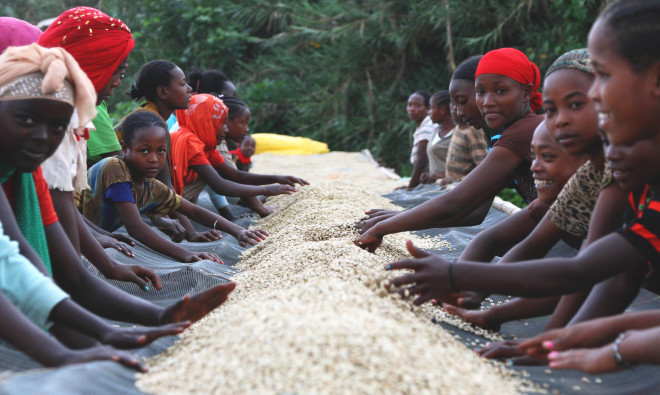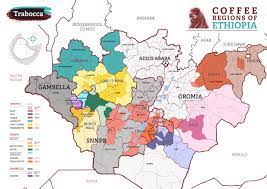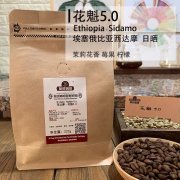What is the wild heirloom coffee bean in Arabica, the main coffee bean growing area in Ethiopia?
Although Ethiopia is famous as the birthplace of coffee, it is still the darling of the boutique coffee industry because of its incredible flavors. It is admittedly difficult to have full traceability in recent history, when new regulations made direct procurement possible.
When did Ethiopia start growing coffee? Coffee is very old in Ethiopia, but coffee cultivation is not. By the end of the 9th century, Ethiopia began to actively grow coffee beans as food, but probably not as a drink, unless it was tea with cherries instead of coffee beans. In most stories, it is the Arab world that develops brewing through a series of accidents. The coffee was accidentally roasted, ground and put into the water. By the time Constantinople fell to the Ottoman Empire in 1453, the good news was that they had brought coffee. Even if coffee becomes an Ethiopian export, Ethiopian coffee is the result of harvesting rather than agricultural practice. A hundred years ago, plantations, mainly in Haller, were still the exception, while "Kafa" coffee in the southwest was still harvested in the wild. In 1935, William Yukes wrote:
"Wild coffee, also known as kafa coffee, comes from one of the areas where it grows most abundantly in its natural state. The trees grow so luxuriantly that the possible supply, at least when collecting labor, is virtually unlimited. It is said that in the southwest of Abyssinia, there are large forests that have never been occupied except in the suburbs. "
After making us all dream of endless Ethiopian wild coffee forests, some of which may never be seen by humans, let alone roasted and brewed, Ukers continues to describe how the coffee is processed: it is discovered in the most primitive way and disappears in a dirty, mixed state. "

Where is the origin of Ethiopian coffee? Over the years, most Ethiopian coffee has come from one of three growing areas: Haller in the east and Yegashafi and Sidamo in the south. Technically, Yirgacheffe is part of Sidamo. Today, boutique coffee can come from several other regions, including Kafa and Lim in the west, and Guji in the south.
At what altitude does Ethiopian coffee grow? All premium Ethiopian coffee grows above 4000 feet, and most of them grow above 6000 feet. In the highlands of Sidamo and Yirgacheffe, coffee can grow above 7000 feet.
It ranks fifth in coffee production. The average annual output is 6740000 bags.

The common Arabica varieties are local varieties and JARC varieties. As the birthplace of coffee, Ethiopia has more species of coffee plants than anywhere else on earth, most of which still grow in the wild, most of which have not yet been discovered. All Ethiopian coffee is Arabica coffee, and at least 150 varieties are grown commercially. Traditionally, these have been simply marked as "heirloom varieties"; however, that is changing as the Jima Agricultural Research Center works to identify species.
Coffee production area is: Djimma | Limu | Nekempt | Guji | Yirgacheffe (Yirga Chefe) | Gedeb | Sidamo | Kochere
Coffee harvest season: October-December at low altitude and November-January at high altitude.
Important Notice :
前街咖啡 FrontStreet Coffee has moved to new addredd:
FrontStreet Coffee Address: 315,Donghua East Road,GuangZhou
Tel:020 38364473
- Prev

The technological process of Humbera coffee beans recommended by Shanquan treatment plant in Esseguji production area
The quality of Qianjie Huakui coffee beans has always been very excellent. The boutique coffee was harvested near the city of Hambella in the Guji region of Ethiopia. The area is more than 2000 meters above sea level. Few plantations are located at this altitude, which is why this naturally processed coffee has a rich fruity flavor and a sweet return of sugar. Huakui in Qianjie is from Shanquan treatment plant.
- Next

Introduction of anaerobic fermentation Coffee Bean Flavor Coffee washing Station of Ethiopian native species WushWush
Wush Wush, which originated in the small town of Wush Wush in the Ethiopia-Cafa Forest, was introduced to a small boutique coffee farm in Colombia 30 years ago. Wush Wush, like Geisha, is a native species from Ethiopia. The difference is that Wush Wush did not shine until it was brought to Colombia, with a flavor and level no less than that of high-end Rosa Coffee.
Related
- Detailed explanation of Jadeite planting Land in Panamanian Jadeite Manor introduction to the grading system of Jadeite competitive bidding, Red bid, Green bid and Rose Summer
- Story of Coffee planting in Brenka region of Costa Rica Stonehenge Manor anaerobic heavy honey treatment of flavor mouth
- What's on the barrel of Blue Mountain Coffee beans?
- Can American coffee also pull flowers? How to use hot American style to pull out a good-looking pattern?
- Can you make a cold extract with coffee beans? What is the right proportion for cold-extracted coffee formula?
- Indonesian PWN Gold Mandrine Coffee Origin Features Flavor How to Chong? Mandolin coffee is American.
- A brief introduction to the flavor characteristics of Brazilian yellow bourbon coffee beans
- What is the effect of different water quality on the flavor of cold-extracted coffee? What kind of water is best for brewing coffee?
- Why do you think of Rose Summer whenever you mention Panamanian coffee?
- Introduction to the characteristics of authentic blue mountain coffee bean producing areas? What is the CIB Coffee Authority in Jamaica?

